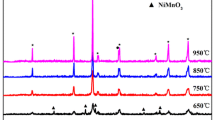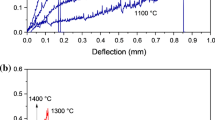Abstract
A new non-destructive method has been developed for determining the internal stress of ferroelectric and ferromagnetic ceramic materials by comparing the relative changes in the permeability of the materials. The first experimental data of the relationship between the residual stress and the microstructure of the ceramic material has been obtained by this method. Residual stress-producing and -releasing behaviours in Ni-Cu-Zn ceramics processing depends on the microstructure of these materials. The experimental results show that more residual stress is produced in quenching and released in annealing for a sample with a lower density, smaller grain sizes and a higher pore fraction. Whether or not the residual stress in a quenched Ni-Cu-Zn ceramic sample is released back to its initial as-sintered state through an annealing process depends upon the microstructure. The stress produced by air-quenching was almost completely released by the annealing process when the relative densities of the samples were lower than 83%. However, the stress-releasing effect decayed rapidly with increasing density when the relative densities of the samples were higher than 94%. On the other hand, the residual stress in the Ni-Cu-Zn ceramics rose very rapidly when the air-quenching temperature was higher than 830 ‡C. The stress was estimated by considering the effect of magnetostriction on the initial magnetization process in the materials. A simple theoretical model has been developed to interpret the results.
Similar content being viewed by others
References
G. Mian and T. Yamaguchi, J. Magn. Magn. Mater. 68 (1987) 351.
J. Smith, in “Magnetic Properties of Materials” (McGraw-Hill, New York, 1973) pp. 110–80.
S. Chikazumi, in “Physics of Magnetism” (Robert E. Krieger Publishing, Malabar, FL, 1964) pp. 161–214.
Author information
Authors and Affiliations
Additional information
Supported in part by The Computer and Communication Promotion Foundation, NEC, Japan (C & C Foreign Researcher Award, 1987).
Rights and permissions
About this article
Cite this article
Mian, G., Yamaguchi, T. The effect of microstructure on residual stress-producing and -releasing mechanisms in ceramics processing. J Mater Sci 26, 1775–1780 (1991). https://doi.org/10.1007/BF00543601
Received:
Accepted:
Published:
Issue Date:
DOI: https://doi.org/10.1007/BF00543601




